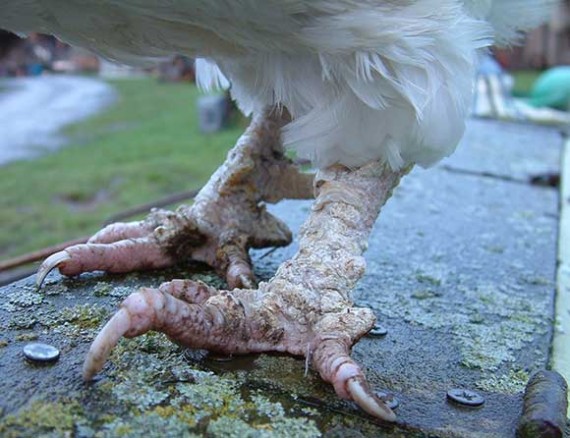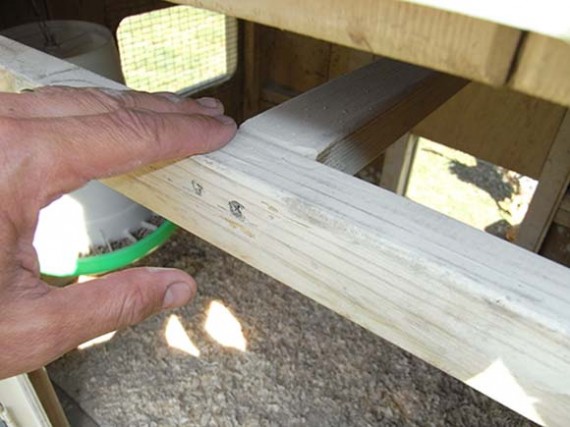Scaly Leg Mites
Older chickens tend to suffer with scaly leg mites more often than young birds. This mite burrows deep underneath the scales of the feet and legs, causing them to become raised and crusty. They cause intense irritation to the poor bird and cause it to walk around stiff legged.
The Signs of Scaly Leg Mites
Scaly leg mites are too small to be seen with the naked eye, however it isn’t difficult to recognise a chicken that has them. You should suspect scaly leg mites if any scales are raised, protrude outwards or look crusty.
Initially, the mites burrow in between scales and produces debris that looks like a white film. Later on, a yellowish crust forms which is attached to the leg.
 The scales of a bird suffering from Scaly Leg Mites. Photo: R. Stephenson
The scales of a bird suffering from Scaly Leg Mites. Photo: R. Stephenson
Treatment
Legs and feet can be washed with warm soapy water and gently scrubbed with an old toothbrush to remove any dead scales.
Scales must not be pulled off, however bad they look. They can be cleaned out with an old toothbrush and softened with petroleum jelly (Vaseline) but new scales must be left to regrow from underneath causing the raised scales to come away naturally. Scales, just like feathers are replaced during the annual moult so it can take up to a year for this to happen.
Veterinary advice recommends dipping the legs into surgical spirits weekly for 3 to 4 weeks, although there are some who say this is painful for the bird and prefer not to do this. Personally, I feel the discomfort of having burrowing mites on your legs far outweighs this treatment.
Ivermectin, is another treatment that is often prescribed. Ivermectin is a systemic inhibitor that kills scaly leg mites as well as other external parasites such as lice and most internal parasites (worms). It must however only be used under the guidance of your vet since it is unlicensed for poultry.
Petroleum Jelly (Vaseline) can be rubbed onto the legs and feet daily. This not only helps to soften the scales but also smothers the mites, causing them to die. It usually has to be done diligently or combined with one of the treatments above though to be completely effective.
Scaly leg mites travel slowly along the perch between birds when they are roosting. Painting clean perches with linseed oil (a sticky, natural oil) can help to stop them in their tracks although be careful because linseed oil is flammable!
A safer option and one that I use is to rub diatomaceous earth onto the perches. This also helps to control red mite during the summer months when they are active.
 Diatomaceous Earth rubbed onto perches.
Diatomaceous Earth rubbed onto perches.
Please do not be tempted to dip hen’s legs into diesel or creosote. This is an old remedy that sometimes gets mentioned on poultry forums but is harmful to them.
- Previous « Lice
- Next Egg production »

About Tim Daniels
Tim is a poultry enthusiast and keeps chickens, ducks, and geese at his home in Bedfordshire. He runs the hobby website poultrykeeper.com in his spare time.
Further Reading
 Chicken & Eggs: River Cottage Handbook No.11 Mark Diacono |  Storey's Guide to Raising Chickens Gail Damerow |  A Beginners Guide to Caring for Ex-Batts Jo Barlow |  Reinventing the Chicken Coop Matthew Wolpe |  Chickens: The Essential Guide to Choosing and Keeping Happy, Healthy Hens Suzie Baldwin |
Smallholding shop
When you click links below and make a purchase, this may result in this site earning a commission from eBay.

Redmite Killer Aerosol 250ml
Specifically blended… from £7.28 + p&p

Hentastic Foraging Feast 1KG Garlic, Ginger & Mixed Herbs
Foraging pellets for… from £3.95 + p&p

28-160 Rutland S/Poultry Net-Double Spike 50m
Super Poultry NettingKeep… from £129.30 + p&p

vital Vits - 250ml
High concentrate of… from £5.58 + p&p
















